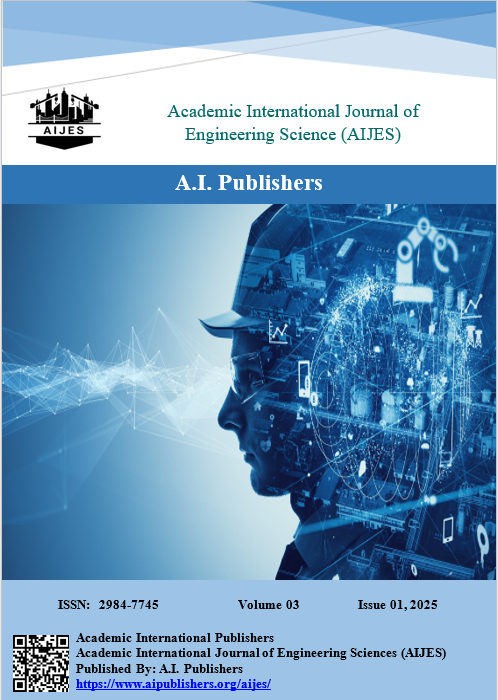A SPICE-Compatible Physics-Inspired Model for Molecular-Type Atomic Switches in Memory and Neuromorphic Circuits
DOI:
https://doi.org/10.59675/E111Keywords:
Atomic switch; SPICE modeling; Filament growth; Plasticity; Calibration; Neuromorphic computingAbstract
Molecular-type atomic switches are an emerging technology in solid-electrolyte electrical devices, serving as nonvolatile memory devices and neuromorphic computers. However, there are no compact physics-inspired behavioral models to enable their integration into circuit-level simulations. This paper introduces a simple SPICE-compatible behavioral model that combines ion-density dynamics, filament growth, and exponential resistance growth to recreate the major experimental behaviors of these devices, such as bistable switching, rate-dependent plasticity, and quantized conductance steps. The model is represented as a set of coupled ordinary differential equations using a two-element state vector, and it is then converted into SPICE primitives as behavioral sources and state holding capacitors in practice. Calibration plans for measurable experimental quantities, such as switching time as a function of bias, threshold voltages, and quantized step magnitudes, are suggested. The resulting framework allows for quick exploration of circuits at the circuit level and evaluates the entire system at the system level, while considering material-specific parameterization demands and possible quantum effects refinements. It is a synthesis of proven experimental and theoretical literature, making it directly applicable to modern memory and neuromorphic applications.
References
Terabe K, Hasegawa T, Nakayama T, Aono M. Quantized conductance atomic switch. Nature. 2005;433(7021):47-50. DOI: https://doi.org/10.1038/nature03190
Waser R, Aono M. Nanoionics-based resistive switching memories. Nat Mater. 2007;6(11):833-40. DOI: https://doi.org/10.1038/nmat2023
Nayak A, Tamura T, Tsuruoka T, Terabe K, Hosaka S, Hasegawa T, et al. Rate-limiting processes determining the switching time in an Ag₂S atomic switch. J Phys Chem Lett. 2010;1(3):604-8. DOI: https://doi.org/10.1021/jz900375a
Nayak A, Tsuruoka T, Terabe K, Hasegawa T, Aono M. Theoretical investigation of kinetics of a Cu₂S-based gap-type atomic switch. Appl Phys Lett. 2011;98(23):233505. DOI: https://doi.org/10.1063/1.3597154
Tsuruoka T, Hasegawa T, Terabe K, Aono M. Conductance quantization and synaptic behavior in a Ta₂O₅-based atomic switch. Nanotechnology. 2012;23(43):435705. DOI: https://doi.org/10.1088/0957-4484/23/43/435705
Wu S, Tsuruoka T, Terabe K, Hasegawa T, Hill JD, Ariga K, et al. A polymer-electrolyte-based atomic switch. Adv Funct Mater. 2010;21(1):93-9. DOI: https://doi.org/10.1002/adfm.201001520
Sillin H, Aguilera R, Shieh H, Avizienis A, Aono M, Stieg AZ, et al. A theoretical and experimental study of neuromorphic atomic switch networks for reservoir computing. Nanotechnology. 2013;24(38):384004. DOI: https://doi.org/10.1088/0957-4484/24/38/384004
Stieg AZ, Avizienis A, Sillin H, Martin-Olmos C, Aono M, Gimzewski JK. Emergent criticality in complex Turing-type atomic switch networks. Adv Mater. 2011;24(2):286-90. DOI: https://doi.org/10.1002/adma.201103053
Ohno T, Hasegawa T, Tsuruoka T, Terabe K, Gimzewski JK, Aono M. Short-term plasticity and long-term potentiation mimicked in single inorganic synapses. Nat Mater. 2011;10(8):591-5. DOI: https://doi.org/10.1038/nmat3054
Sheridan P, Kim S, Gaba S, Chang T, Chen L, Lü W. Device and SPICE modeling of RRAM devices. Nanoscale. 2011;3(9):3833-43. DOI: https://doi.org/10.1039/c1nr10557d
Sakamoto T, Lister K, Banno N, Hasegawa T, Terabe K, Aono M. Electronic transport in Ta₂O₅ resistive switch. Appl Phys Lett. 2007;91(9):092106. DOI: https://doi.org/10.1063/1.2777170
Tamura T, Hasegawa T, Terabe K, Nakayama T, Sakamoto T, Sunamura H, et al. Switching property of atomic switch controlled by solid electrochemical reaction. Jpn J Appl Phys. 2006;45(4L):L364-6. DOI: https://doi.org/10.1143/JJAP.45.L364
Kubota H, Hasegawa T, Akai-Kasaya M, Asai T. Reservoir computing on atomic switch arrays with high precision and excellent memory characteristics. J Signal Process. 2021;25(4):123-6. DOI: https://doi.org/10.2299/jsp.25.123
Chua LO. Memristor-the missing circuit element. IEEE Trans Circuit Theory. 1971;CT-18(5):507-19. DOI: https://doi.org/10.1109/TCT.1971.1083337
Strukov DB, Snider GS, Stewart DR, Williams RS. The missing memristor found. Nature. 2008;453(7191):80-3. DOI: https://doi.org/10.1038/nature06932
Zhu LQ, Wan CJ, Guo LQ, Shi Y, Wan Q. Organic neuromorphic transistors for synaptic plasticity and learning. Adv Mater. 2014;26(19):3063-8.
Chang T, Jo SH, Kim KH, Sheridan P, Gaba S, Choi W. Synaptic behaviors and modulation characteristics of a metal-oxide memristor. Appl Phys Lett. 2011;99(6):063108.
Schwemmer M, Newby J. Metastable switching in a planar limit cycle system with additive noise. Physica D Nonlinear Phenomena. 2016;317:15-27. DOI: https://doi.org/10.1016/j.physd.2015.12.006
Banerjee W, Hwang H. Quantized conduction device with 6-bit storage based on electrically controllable break junctions. Advanced Electronic Materials. 2019;5(12):1900744. DOI: https://doi.org/10.1002/aelm.201900744
Araki M, Hasegawa T. Development of a metal oxide-based molecular-gap atomic switch for unconventional computing. Japanese Journal of Applied Physics. 2020;59(4):040605. DOI: https://doi.org/10.35848/1347-4065/ab8026
Godlewski S, Kawai H, Kolmer M, Zuzak R, Echavarren A, Joachim C, et al. Single-molecule rotational switch on a dangling bond dimer bearing. ACS Nano. 2016;10(9):8499-507. DOI: https://doi.org/10.1021/acsnano.6b03590
Seo G, Kim B, Lee Y, Kim H. Photo-assisted bistable switching using mott transition in two-terminal VO₂ device. Applied Physics Letters. 2012;100(1):011908. DOI: https://doi.org/10.1063/1.3672812
Conti I, Buma W, Garavelli M, Amirjalayer S. Photoinduced forward and backward pedalo-type motion of a molecular switch. The Journal of Physical Chemistry Letters. 2020;11(12):4741-6. DOI: https://doi.org/10.1021/acs.jpclett.0c01094
Kubota H, Hasegawa T, Akai-Kasaya M, Asai T. Behavioral model of molecular gap-type atomic switches and its SPICE integration. Circuits Syst. 2022; 13:1–1. DOI: https://doi.org/10.4236/cs.2022.131001
Downloads
Published
Issue
Section
License
Copyright (c) 2023 Academic International Journal of Engineering Sciences

This work is licensed under a Creative Commons Attribution 4.0 International License.





